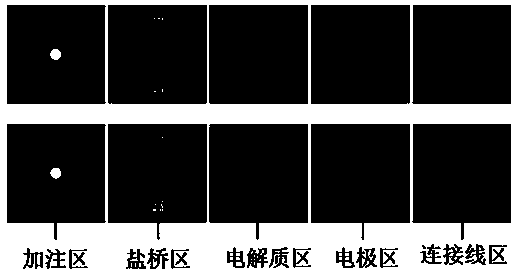A preparation method of a sensor for detecting organophosphorus pesticide residues
A technology of organophosphorus pesticides and sensors, which is applied in the direction of chemiluminescence/bioluminescence, and analysis by making materials undergo chemical reactions, and can solve the problem that multifunctional electrochemical and chemiluminescence analyzers are expensive and cannot meet the actual detection and detection costs. Advanced problems, to achieve the effect of reducing detection cost, simple preparation method, and simple preparation
- Summary
- Abstract
- Description
- Claims
- Application Information
AI Technical Summary
Problems solved by technology
Method used
Image
Examples
Embodiment 1
[0024] Example 1. Preparation method of electrochemiluminescence sensor for detecting methyl parathion pesticide residues
[0025] (1) Design with CorelDRAW Graphics Suite X6, Adobe Photoshop CS6 or AdobeIllustrator CS6 software such as figure 1 The paper battery pattern shown includes a filling area, a salt bridge area, an electrolyte area, a battery area and a connecting wire area.
[0026] (2) Cut the filter paper into A4 size, use a solid wax printer to print the pattern designed in step (1) on the cut filter paper, and then place the printed filter paper in an oven at 90°C for heat treatment 3 min to melt the patterned wax and form a hydrophobic dam.
[0027] (3) Use a punch or laser cutting machine to drill holes in the center of the filling area, the diameter of the hole is 1 mm smaller than the diameter of the reserved hydrophilic area; drop 1.0 M NaCl solution or KCl solution in the salt bridge area; in the electrolyte 0.9 MCu(NO 3 ) 2 Solution and 0.6 M Al(NO 3 ) 3 Solutio...
Embodiment 2
[0035] Example 2. Preparation method of an electrochemiluminescence sensor for detecting residues of systemic phosphorus pesticides
[0036] The preparation steps are the same as in Example 1, the difference is:
[0037] The diameter of the filling area of the paper battery described in step (1) is 5 mm; the width of the salt bridge area is 5 mm and the length is 12 mm; the diameter of the electrolyte area is 5 mm; the diameter of the battery area is 5 mm; the diameter of the connecting wire area is 5 mm.
[0038] The self-made chip holder described in step (3) includes 2 pieces, one of which has a hole in the middle, and the size of the hole is the same as the size of the hole in the filling area; the other piece of chip holder has a conductive aluminum circuit, which can be connected The current on it is drawn.
[0039] The organophosphorus pesticide in step (5) is a systemic phosphorus pesticide.
Embodiment 3
[0040] Example 3. Preparation method of electrochemiluminescence sensor for detecting malathion pesticide residues
[0041] The preparation steps are the same as in Example 1, the difference is:
[0042] The diameter of the filling area of the paper battery described in step (1) is 6 mm; the width of the salt bridge area is 8 mm and the length is 16 mm; the diameter of the electrolyte area is 8.0 mm; the diameter of the battery area is 8 mm; the diameter of the connecting wire area is 8 mm.
[0043] The self-made chip holder described in step (3) includes 2 pieces, one of which has a hole in the middle, and the size of the hole is the same as the size of the hole in the filling area; the other piece of chip holder has a conductive aluminum circuit, which can be connected The current on it is drawn.
[0044] The organophosphorus pesticide in step (5) is malathion pesticide.
PUM
| Property | Measurement | Unit |
|---|---|---|
| diameter | aaaaa | aaaaa |
| diameter | aaaaa | aaaaa |
| diameter | aaaaa | aaaaa |
Abstract
Description
Claims
Application Information
 Login to View More
Login to View More - R&D
- Intellectual Property
- Life Sciences
- Materials
- Tech Scout
- Unparalleled Data Quality
- Higher Quality Content
- 60% Fewer Hallucinations
Browse by: Latest US Patents, China's latest patents, Technical Efficacy Thesaurus, Application Domain, Technology Topic, Popular Technical Reports.
© 2025 PatSnap. All rights reserved.Legal|Privacy policy|Modern Slavery Act Transparency Statement|Sitemap|About US| Contact US: help@patsnap.com


